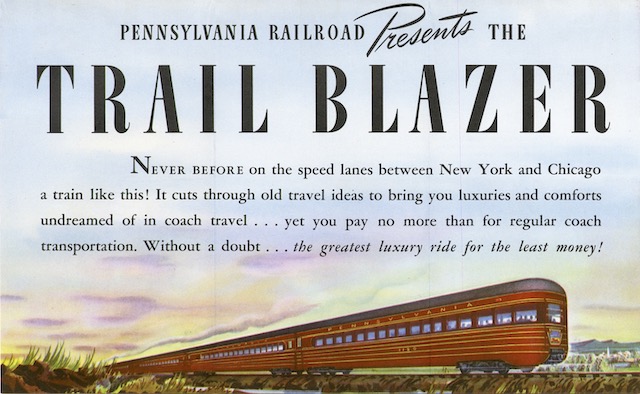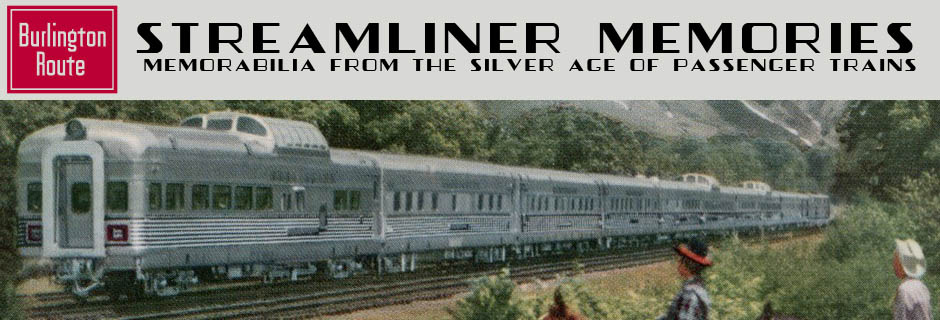If the all-Pullman Broadway Limited was a basket case before the war, the all-coach Trail Blazer was Pennsylvania’s success story. Inaugurated on July 28, 1939, the same day as New York Central’s all-coach Pacemaker, the Trail Blazer attracted 16 percent more passengers and earned 24 percent more revenue per train-mile in its first year than the Pacemaker. In its first year it also attracted 35 times as many passengers as the Broadway.

Click image to download a 2.4-MB PDF of this brochure.
The original eight-car train included a coach-baggage car, four full coaches, a kitchen-dormitory car, an entire car dedicated to dining, and a coach-observation-lounge car. These cars were rebuilt and streamlined in PRR’s own shops out of heavyweight cars. Externally, the train’s two-tone red and gold pinstripes and round-tail observation car made it nearly indistinguishable from its all-Pullman counterparts, while the Pacemaker initially used just ordinary heavyweight cars. Until 1948, the train was pulled by steam locomotives, often the Loewy-streamlined S-1 6-4-4-6 or the unstreamlined but no less impressive S-2 6-8-6.
The train was also fast, taking just an hour longer to get from New York to Chicago than the Broadway but at a far lower fare. To save time, the westbound train made just six stops between New York and Pittsburgh, but only to board passengers, and just seven stops between Pittsburgh and Chicago, but only to drop off passengers, with eastbound in reverse. Only at Pittsburgh were passengers allowed to both get on and off the train.
Clearly inspired by the El Capitan and Challenger, the train’s seats were far more comfortable than on coaches from just a few years before and the meals in the diner started at 50 cents for breakfast, 65 cents for lunch, and 75 cents for dinner (about $11, $14, and $16 in today’s dollars respectively). The train was so successful that it usually operated with at least two extra coaches and sometimes in two or three sections.
The “luxuries” touted by this brochure seem common today, especially to anyone who rode post-war streamliners. But before the El Capitan and Challenger, coaches were third-class travel with all of the negative implications that implies: uncomfortable seats, no access to lounge areas, and the presumption that anyone who rode coach couldn’t afford to eat in the diner. The increased amenities and comforts offered to coach passengers in the streamliner era represented a democratization of travel necessitated by competition from buses and automobiles.

It has always been my impression that sleeping car passengers were more likely to be end-to-end passengers, whereas coaches were for those traveling from one end to an intermediate point, or between intermediate points.
What’s interesting to me is why Pennsy had such a tough time attracting riders to its flagship. I suppose there were those who felt that given a choice between the all-Pullman General and the Broadway, having to leave either NYC or Chicago an hour earlier was no big deal.
And it’s not like PRR management didn’t know what the Central was up to: both “new” trains launched on the same day. Did the Broadway’s refreshed and streamlined heavyweight equipment really suffer that badly by comparison? Or maybe it was Central’s water level route which was quite smooth, while PRR had to deal with the horseshoe and mountainous railroading which implies hard braking along the way and therefore a not as restful sleep.
The link to the pamphlet at the top is not working. If you could please fix it, that would be greatly appreciated.
Fixed the link. Sorry for the delay.
Joe,
Remember that the Broadway’s problems were pre-war. After the war, the Broadway did fine. Before the war, due to the lingering effects of the Depression, there probably was just too much capacity in the New York-Chicago corridor. NYC did a better job of marketing and PRR crippled itself by offering trains like the General that were almost as good as the Broadway and almost as fast for lower fares.